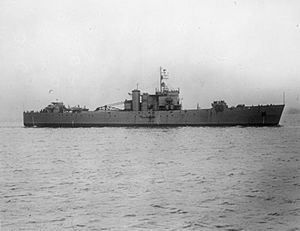HMS Bruiser (F127) facts for kids
HMS Bruiser was a special kind of ship called a Landing Ship, Tank (LST). It was built to carry tanks, vehicles, and soldiers directly onto beaches during wartime. The ship was built by Harland and Wolff and launched in October 1942. It joined the Royal Navy in March 1943 and played an important role in World War II.
Building a Landing Ship, Tank
The Bruiser was the second ship of its kind, known as the LST Mark I class. These ships were designed to carry a lot of military equipment. Bruiser could hold 13 Churchill tanks, 27 other vehicles, and nearly 200 soldiers.
One special feature was its speed. Even when fully loaded for an attack, it could travel at about 18 knots (about 33 kilometers per hour). However, it needed a very long ramp, about 140 feet (43 meters) long, to get vehicles onto the beach. This ramp took up a lot of space inside the ship.
Bruiser had only two sister ships. Plans for more LST Mark I ships were changed. Instead, a new, simpler design was created in the United States. These new ships were slower but could still carry a similar amount of cargo.
Bruiser's War Service
Bruiser was very busy during World War II. In 1943, it took part in the Salerno landing in Italy. This was a major operation where Allied forces landed on beaches to fight against enemy troops.
In 1944, Bruiser was changed into a special ship called a fighter direction ship. Its job was to help control fighter planes during battles. It was used for this role during the Normandy landings, also known as D-Day. This was a huge invasion where Allied forces landed in France to free Europe. Bruiser helped guide the fighter aircraft from the sea.
Later in 1944, Bruiser helped British troops return to Athens, the capital city of Greece. After the war ended, in 1946, the Royal Navy sold Bruiser for civilian use.
Life as a Merchant Ship
After leaving the navy, Bruiser was renamed Nilla and began a new life as a merchant ship. Merchant ships carry goods and passengers for trade.
In 1951, it was changed again, this time into a cargo liner, and renamed Silverstar. Cargo liners carry both cargo and a small number of passengers on regular routes. In 1957, the ship was renamed one last time to Ciudad de Santa Fe. It continued to serve as a cargo ship until 1968. That year, it was taken apart for scrap in Argentina.
See also


